Final harmony – Wimpfen
But there is still no end to gazing and admiring. To the right on the slope we see Ehrenberg Castle with extensive ruins and a more modern inhabited castle building, overtopped by a powerful tower and embellished by the pretty little turret of the old chapel. The lords of Ehrenberg, who had their seat here for hundreds of years, once provided the old empire with many a worthy dignatory and scholar. Now it is a pleasure to wander through the ruins and if possible to visit the elevated church in nearby Heinsheim with its interesting tombstones of the lords of Ehrenburg.
And now, long heralded by the silhouette of Wimpfen seen from afar, we approach the final harmony of this journey. Like a fairy-tale, town wall and towers, houses and battlements look down into the valley from the crest of the hill. But up above in the little town it sounds like the verses of an old song when we glance into the narrow alleyways and the fountains murmer the same beautiful melody. The Middle Ages seem to weave themselves around us. It is a humpbacked world between these magnificent framework houses, almost all of them with each upper storey leaning out a little farther: we see many an artistic old wrought iron inn sign, romantic corners invite us to linger and gaze. The window arcades alone make a splendid picture of the remains of the Barbarossa Castle, and there are the fine buildings and sculptures of the churches and monasteries. The two lofty towers make a deep impression and how inquisitively the Nürnberger turret looks down into the world around it! Were one to enumerate all the details there would be a long list. One must stroll through Wimpfen with open eyes and with an open heart. Yes, one must stroll, not hasten!
Besides the beauties of olden times there are also lovely views from several places: the extensive Neckar bend lying below us, to the right up in Bad Friedrichshall, in the middle over the dark forest to the Löwenstein mountains and to the left once again Hornberg Castle. This panorama is among the most beautiful in our district. Before the canalization of the Neckar one could observe from up here how the boats coming from Jagstfeld shot and pitched through the Wimpfen rapids, an experience awaited with anxious suspense by everyone in small boats. In recent time more stress has been laid on the mineral waters in Wimpfen, and thus part of the town has a more modern air, but without affecting the beautiful old character in any way. This is shown in the changed name: once "Wimpfen on the Mountain", now "Wimpfen Spa".
The oldest town seal already speaks in 1250 of "Royal Wimpfen". In the Imperial Palace, probably one of the largest castles of this kind in the old German Empire, the Hohenstaufen Emperor Barbarossa, Heinrich VI, Friedrich II and Heinrich VII often held their court here for long periods of time in the 12th and 13th centuries, until finally Wimpfen became a free imperial city, and even without the support of the imperial suzerainty it flourished for hundreds of years as a commercial town. Those were the times when a wealthy bourgeoisie was able to endow churches and monasteries with important works of art, among them the magnificent crucifixion group by Hans Backoffen from the 15th century. And below in Wimpfen im Tal – “Wimpfen in the Valley" — the splendid early Gothic monastery church of St. Peter arose on the foundations of a large Roman central church. No-one visiting Wimpfen should neglect to view this. The cloisters of the church, which together with the neighbouring buildings belonging to it recently came into the charge of monks of a former Silesian order, are of exquisite beauty.
With all this profusion it is difficult to leave Wimpfen, for at the same time it means a farewell to the long and beautiful journey that has led us here from Heidelberg. We go down to the Neckar once more, glance forward into the wide landscape of Neckarsulm and Heilbronn, from whence the sparkling, silver Neckar flows towards us — a well-loved river coming from the heart of Wuerttemberg. Here, where at a short distance from one another the Jagst and Kocher flow into it, the youthful Neckar first attains its manhood and is thus prepared for the course through its most beautiful stretch from Wimpfen to Heidelberg. And once more we glance at the famous silhouette of Wimpfen up on the mountain in order to salute it.
The pictures in this book accompany our ramblings and show nearly everything described here in beautiful, clear photographs. They show how very much the Neckar itself is the soul of this landscape.
And now, long heralded by the silhouette of Wimpfen seen from afar, we approach the final harmony of this journey. Like a fairy-tale, town wall and towers, houses and battlements look down into the valley from the crest of the hill. But up above in the little town it sounds like the verses of an old song when we glance into the narrow alleyways and the fountains murmer the same beautiful melody. The Middle Ages seem to weave themselves around us. It is a humpbacked world between these magnificent framework houses, almost all of them with each upper storey leaning out a little farther: we see many an artistic old wrought iron inn sign, romantic corners invite us to linger and gaze. The window arcades alone make a splendid picture of the remains of the Barbarossa Castle, and there are the fine buildings and sculptures of the churches and monasteries. The two lofty towers make a deep impression and how inquisitively the Nürnberger turret looks down into the world around it! Were one to enumerate all the details there would be a long list. One must stroll through Wimpfen with open eyes and with an open heart. Yes, one must stroll, not hasten!
Besides the beauties of olden times there are also lovely views from several places: the extensive Neckar bend lying below us, to the right up in Bad Friedrichshall, in the middle over the dark forest to the Löwenstein mountains and to the left once again Hornberg Castle. This panorama is among the most beautiful in our district. Before the canalization of the Neckar one could observe from up here how the boats coming from Jagstfeld shot and pitched through the Wimpfen rapids, an experience awaited with anxious suspense by everyone in small boats. In recent time more stress has been laid on the mineral waters in Wimpfen, and thus part of the town has a more modern air, but without affecting the beautiful old character in any way. This is shown in the changed name: once "Wimpfen on the Mountain", now "Wimpfen Spa".
The oldest town seal already speaks in 1250 of "Royal Wimpfen". In the Imperial Palace, probably one of the largest castles of this kind in the old German Empire, the Hohenstaufen Emperor Barbarossa, Heinrich VI, Friedrich II and Heinrich VII often held their court here for long periods of time in the 12th and 13th centuries, until finally Wimpfen became a free imperial city, and even without the support of the imperial suzerainty it flourished for hundreds of years as a commercial town. Those were the times when a wealthy bourgeoisie was able to endow churches and monasteries with important works of art, among them the magnificent crucifixion group by Hans Backoffen from the 15th century. And below in Wimpfen im Tal – “Wimpfen in the Valley" — the splendid early Gothic monastery church of St. Peter arose on the foundations of a large Roman central church. No-one visiting Wimpfen should neglect to view this. The cloisters of the church, which together with the neighbouring buildings belonging to it recently came into the charge of monks of a former Silesian order, are of exquisite beauty.
With all this profusion it is difficult to leave Wimpfen, for at the same time it means a farewell to the long and beautiful journey that has led us here from Heidelberg. We go down to the Neckar once more, glance forward into the wide landscape of Neckarsulm and Heilbronn, from whence the sparkling, silver Neckar flows towards us — a well-loved river coming from the heart of Wuerttemberg. Here, where at a short distance from one another the Jagst and Kocher flow into it, the youthful Neckar first attains its manhood and is thus prepared for the course through its most beautiful stretch from Wimpfen to Heidelberg. And once more we glance at the famous silhouette of Wimpfen up on the mountain in order to salute it.
The pictures in this book accompany our ramblings and show nearly everything described here in beautiful, clear photographs. They show how very much the Neckar itself is the soul of this landscape.
Dieses Kapitel ist Teil des Buches The Neckar Valley. From Heidelberg to Wimpfen
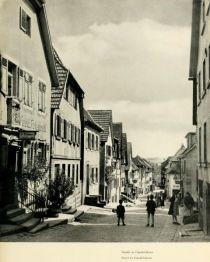
057 Straße in Gundelsheim
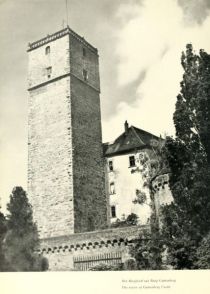
058 Der Bergfried auf Burg Guttenberg
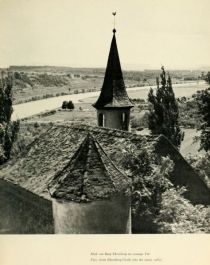
059 Blick von Burg Ehrenberg ins sonnige Tal
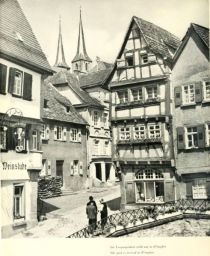
060 Die Vergangenheit steht auf in Wimpfen
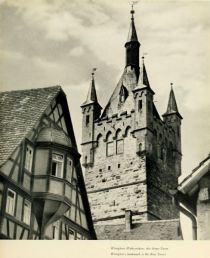
061 Wimpfens Wahrzeichen, der blaue Turm
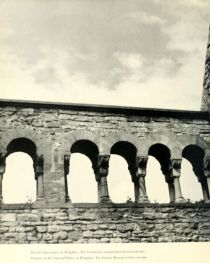
062 Rest der Kaiserpfalz zu Wimpfen
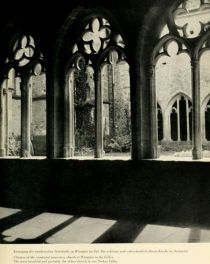
063 Kreuzgang der wundervollen Stiftskirche zu Wimpfen im Tal. Die schönste und wahrscheinlich älteste Kirche im Neckartal
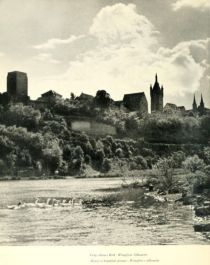
064 Ewig schönes Bild - Wimpfens Silhouette
alle Kapitel sehen